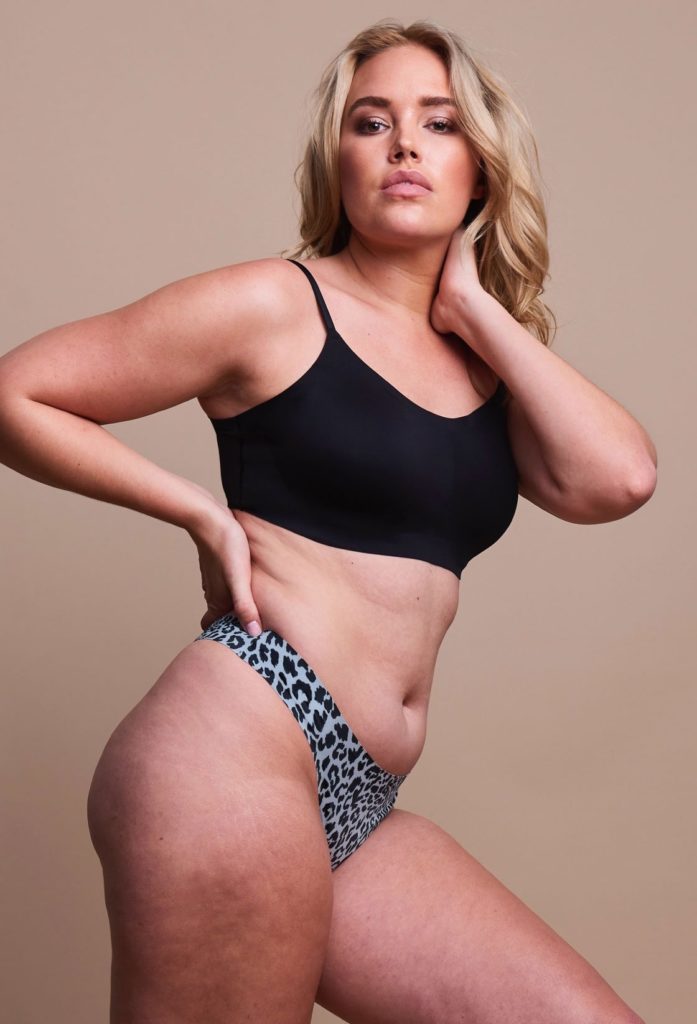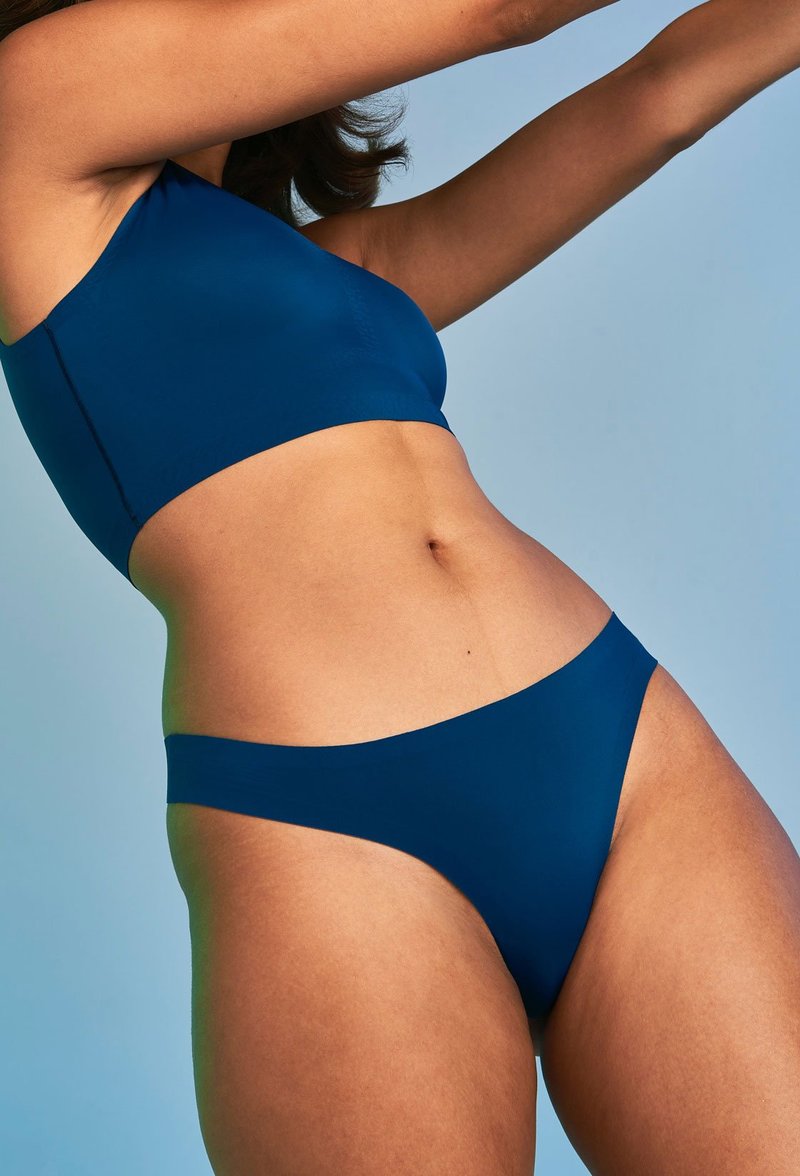Thongs are a powerful type of panty that exert confidence, control, and comfort. However, for many women, thongs can be intimidating. The exposed buttock area and minimal coverage can seem like a big change, especially if you are used to wearing other underwear types, such as briefs, that are more conservative.
Understanding when you should or shouldn’t wear a thong is essential knowledge for women, especially when it comes to sensitive areas. This guide covers all you need to know about thongs, so you can embrace your body comfortably and safely, no matter what you’re wearing!
What is a Thong?
Thongs are widely considered to be one of the most stylish, fashionable, and sexiest forms of women’s undergarments. An undergarment typically constitutes a thong when it is shaped with more material coverage in the front and less in the back, creating a small triangle shape. The bum cheeks are usually exposed with little to no coverage.
A traditional thong is considered stylish and sexy mainly due to the range of materials they are available in, as well as this lack of coverage. Thong underwear also comes in many designs that can expose more or less skin. The thong style is largely popular for its lack of panty lines, as the smaller amount of material means that you can avoid panty lines when wearing form-fitting clothing.
Thongs can also have a more comfortable fit for everyday use depending on their material. Cotton and microfiber materials are stretchy and breathable, making them great materials for comfortable thongs that you can lounge around in.
At EBY, our thong panties collection embodies the perfect balance of comfort and style, enabling you to not only look sexy but feel it too! With EBY’s unique no-slip nylon grip, our thongs provide unrelenting support despite their seamless appearance. Available in a range of beautiful neutral shades and bold prints, we have the perfect thong for whatever mood you’re in!
A Beginners Guide to Thongs
Thongs come in a range of unique styles, materials, and shapes. Once you’ve found the right thong for your body, you’ll open up a world of modern, fashionable underwear that prioritizes comfort and confidence.
Understanding How Thongs Feel
Wearing a thong for the first time may feel weird or different. This is completely normal and to be expected for first-time thong wearers. The different styles of fit will alter your sensation of wearing panties, especially if you’re used to more full coverage regular underwear.
After a few days, your body will adjust to the feel of thongs and it’s likely that you’ll find them extremely comfortable. If you’re wearing the right size and find a material you like, it will almost feel like you’re wearing nothing at all!
Try Different Styles and Fabrics
How thongs feel is also heavily dependent on the type of material and fabric used.
Silk and satin thongs are soft and gentle on the sensitive areas of skin, whereas the texture of lace thongs may not be suitable for long periods of wear. A thong made of thin cotton will offer the most stretch for a comfortable wearing experience.
Getting Used to Wearing Thongs
It may take a few wears before you feel comfortable wearing thongs! If you’re a first-time thong wearer, there are some important factors that you’ll need to consider to avoid any initial discomfort.
To find the right thong for you, make sure you follow these top tips and tricks:
Pick The Right Size
Firstly, when you first start to wear thongs, it’s important that you choose the right size.
In terms of sizing, start with a thicker waistband that sits comfortably around your hips. To feel more secure, a high-waisted thong will be best as these often come with a wide waistband. You’ll want the waistband to fit snug on your hips without causing pain or discomfort.
Typically, you should choose a thong in the same size as you wear your pants. However, if the thong is too loose, it’ll keep slipping down. If this is the case, you’ll need to pick a smaller size.
Alternatively, if the thong doesn’t provide much coverage towards the front, or the waistband is digging into your hips, you’re probably wearing a size that’s too small for you.

Wear Them Around The House
Just like you’d break in a pair of new shoes, try wearing your thongs around the house first. By doing this, you’ll quickly learn if you’re wearing the right size and you’ll feel more confident wearing them out.
Adjusting your underwear in public is tricky, so getting used to the feel of a thong in the comfort of your own home first is key!
Adjust to Them Slowly
Try wearing a thong for a few hours at first before slowly increasing to a whole day. Start off with comfortable cotton material, rather than going straight in at the deep end with a G-string! This will help your body to adjust to the new sensation and slowly build up your confidence.
Avoid Wearing Thongs Every Day
Wearing a thong every day can lead to skin irritation as well as an increased risk of a minor infection. For this reason, it’s important to have a break between wears to avoid chafing or a painful rubbing feeling.
Don’t Wear Thongs When Sick
Generally, when you are sick, your immune system is momentarily lowered. This means that your body won’t be able to fight off infections as quickly as usual. As thongs absorb a lot of moisture, there is a chance of an infection occurring should you wear them for too long. Hence, it’s best to avoid wearing thongs when sick for health and safety reasons!
Pros of Wearing a Thong
There are many advantages to wearing thong-style panties, which is why most women favor thongs above other forms of underwear. In fact, research has shown that almost a fifth of American women wears thongs on a near-daily basis!
Reduces Panty Lines
Thong underwear can help you to wear a wider range of clothing where a visible panty line may have been a prior issue, from yoga pants to tight dresses! No matter how tight-fitting or thin the clothing material is, wearing a thong reduces the appearance of panty lines, creating the illusion of a seamless silhouette.
Visible panty lines can be embarrassing or simply unflattering. Wearing a thong will help to improve the overall look of the outfit, as well as your confidence!
Sexiness Factor and Boost Overall Confidence
Thongs are considered one of the sexiest forms of underwear, as they are flattering and flirty. The perfect thong can boost confidence and increase your self-esteem.
Comfortable
Cotton thongs are extremely comfortable, whether you are wearing yoga pants or jeans! The soft material is stretchy and breathable.
At EBY, our seamless thongs are uniquely made with a no-slip nylon grip. This means no chafing, no riding up, and no slipping down! As a result, your thong will stay in place all day long for extra support and comfort.
Stylish, Fashionable Designs
Thong underwear is available in many different fashionable designs. While neutrals and skin tones are great for a classic, timeless look (such as this elegant black thong by EBY), sometimes you want a bold or colorful pattern to reflect how you feel!
As thongs are so popular with women, there are a lot of beautiful patterns available in a range of materials. At EBY, our favorite designs include daring animal prints and soft floral patterns.
Cons of Wearing a Thong
Though thongs are great in many ways, they come with a few drawbacks. These are as follows:
Not a Period Friendly Panty
Thongs are generally advised against wearing during your period. While there are thong panty liners available, they are unlikely to stay secure or feel comfortable.
Pads and tampons are also very difficult to use when wearing a thong, due to the little amount of material to work with and the tighter nature of the thong.
Not Suited for Hemorrhoids
Hemorrhoids increase the sensitivity of your skin. While some thong materials may feel soft at first, wearing a pair while walking, exercising, or even sleeping can lead to chafing due to their unique fit.
Not Easy To Exercise In
Wondering how uncomfortable thongs can be? Wearing a thong while exercising can lead to chafing in the butt cheeks area. Additionally, excess sweat can increase the risk of a bacterial infection.
We recommend opting for more breathable panties while exercising.
“Whale Tail”
This happens when the waistband of your thong rises above your pants, creating an unflattering look that resembles a whale tail. Fortunately, this fashion faux pas can be easily avoided by wearing an outfit suitable for a thong. To prevent a whale tail from occurring, it’s best to avoid low-rise jeans or skirts.
Different Types of Thongs
There are three main types of thongs, including cotton, lacy and cheeky:
Cotton Thong
Cotton is a fabric that is gentle on the skin, with quick absorbency. This reduces the risk of excess moisture building up, preventing the likeliness of bacterial infections.
Lacy Thong
While lace thongs have a beautiful and delicate appeal, the texture can be harsh on sensitive skin. Therefore, lacy thongs are best saved for special romantic occasions.
Cheeky Thong
This style is great for those new to thongs as it offers more coverage alongside the back and hip area. Many bikini bottoms use this thong style to provide support while minimizing obvious tan lines.
What Is The Difference Between a G-string and a Thong?
G-strings and thongs are often used interchangeably due to their lack of coverage when compared to average underwear. However, this is a common misconception.
A G-string is an extreme variation of the thong, opting for a thin string that sits between the buttocks, connecting the front to the waistband. Alternatively, fancy thongs use a wider piece of material for a more secure fit and increased coverage.
Conclusion
Thongs are a fun and flirty panty style that is guaranteed to boost your confidence! It’s important to remember that while thongs are an essential part of many women’s wardrobes, they are not always practical for everyday wear or strenuous activities. From styling to safety, this guide will ensure that you find the best thong for you!



